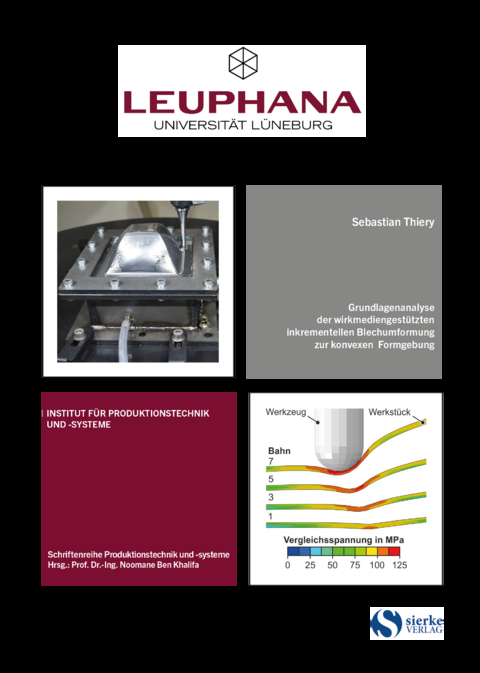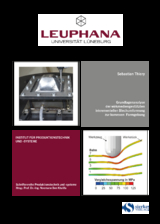Grundlagenanalyse der wirkmediengestützten inkrementellen Blechumformung zur konvexen Formgebung
Seiten
2023
sierke VERLAG - Sierke WWS GmbH
978-3-96548-165-7 (ISBN)
sierke VERLAG - Sierke WWS GmbH
978-3-96548-165-7 (ISBN)
Die wirkmediengestützte inkrementelle Blechumformung ist ein
neuartiges Verfahren zur Herstellung kombinierter konvex-konkaver
Formen, ohne dass eine feste Abstützung des Werkstücks oder
ein zwischenzeitliches Wenden erforderlich sind. Die Kombination
aus Werkzeugbewegung auf der Oberseite und Druckbeaufschlagung
durch das Wirkmedium auf der Unterseite des Werkstücks
ermöglicht eine konvexe Formgebung. Es wird ein Versuchsaufbau
für die Verwendung von Druckluft als Wirkmedium entwickelt.
Der Werkzeugpfad für die konvexe Umformung ist zweidimensional
und entspricht nicht der dreidimensionalen Sollgeometrie. Dieser
Umstand macht es schwierig, konvexe und kombinierte Formen
zielsicher herzustellen. Das folgende Ziel ist es, die physikalischen
Prinzipien der konvexen Formgebung zu verstehen und Strategien
zur Beherrschung des Fertigungsprozesses zu entwickeln.
Numerische und analytische Methoden werden eingesetzt, um die
Umformmechanismen zu identifizieren. Experimentelle Untersuchungen
zeigen, dass die konvexe Formgebung durch Risse und
Sicken entlang der Werkzeugbahn begrenzt wird. Eine zweistufige
Umformstrategie und eine optimierte Werkzeuggeometrie werden
genutzt, um die Geometriegenauigkeit bei konstantem Wirkmediendruck
zu verbessern. Diese Maßnahmen widersprechen jedoch
der Idee eines flexiblen Fertigungsprozesses ohne zwischenzeitliches
Wenden des Werkstücks. Daher ist die dynamische Anpassung
des Wirkmediendrucks während des Fertigungsprozesses
im Rahmen eines Regelkreises eine geeignetere Methode. Die abschließenden
Versuche bestätigen die Wirksamkeit der Regelung
und zeigen, dass die Geometriegenauigkeit verbessert und die vertikale
Umformkraft stabilisiert wird. The strength of incremental sheet forming is its high flexibility. The tool movement
performs the forming operation and the geometric information of the product is stored
in the tool path. The desired shape can be composed of concave and convex elements.
The manufacturing of combined convex-concave shapes requires an additional support
beneath the workpiece. This support can be a solid die or a second movable tool. Alternatively,
a combined convex-concave shape can be produced by two concave forming
operations. However, this strategy requires an intermediate turning of the workpiece.
A novel type of incremental sheet forming process for producing combined convexconcave
shapes without any solid support or turning steps is presented. This process is
called incremental sheet forming with active medium. The combination of tool movement
on the upper side and pressurisation by an active medium on the lower side of the
workpiece enables convex forming operations. An experimental setup is developed to
use pressurised air as active medium. Preliminary experiments successfully prove the
feasibility of the new manufacturing process. However, the tool path for convex forming
is plane and does not correspond to the three-dimensional target shape. These circumstances
make it challenging to accurately produce both convex and combined convexconcave
shapes. The subsequent goal is to understand the physical principles of convex
forming and find methods to control the manufacturing process.
Numerical and analytical techniques are used to identify the forming mechanisms. Experimental
investigations reveal that convex forming is limited by cracks as well as
grooves along the tool path. Moreover, the use of a constant pressure level does not lead
to a steady state in the manufacturing process. Therefore, additional measures are required
to achieve the target shape. A two-stage forming strategy and an optimised tool
geometry are proposed to improve geometric accuracy. Although these measures have
a positive influence on the forming process, they contradict the idea of a flexible manufacturing
process without turning steps. Hence, the dynamical adjustment of the pressure
during the manufacturing process by means of closed-loop control is a preferable
method to reduce geometric deviations. The final experiments validate the effectiveness
of the closed-loop control and demonstrate that the vertical forming force is stabilised
by adjusting the pressure. The closed-loop control is a vital prerequisite for incremental
sheet forming with active medium to exploit the potential of creating combined shapes.
neuartiges Verfahren zur Herstellung kombinierter konvex-konkaver
Formen, ohne dass eine feste Abstützung des Werkstücks oder
ein zwischenzeitliches Wenden erforderlich sind. Die Kombination
aus Werkzeugbewegung auf der Oberseite und Druckbeaufschlagung
durch das Wirkmedium auf der Unterseite des Werkstücks
ermöglicht eine konvexe Formgebung. Es wird ein Versuchsaufbau
für die Verwendung von Druckluft als Wirkmedium entwickelt.
Der Werkzeugpfad für die konvexe Umformung ist zweidimensional
und entspricht nicht der dreidimensionalen Sollgeometrie. Dieser
Umstand macht es schwierig, konvexe und kombinierte Formen
zielsicher herzustellen. Das folgende Ziel ist es, die physikalischen
Prinzipien der konvexen Formgebung zu verstehen und Strategien
zur Beherrschung des Fertigungsprozesses zu entwickeln.
Numerische und analytische Methoden werden eingesetzt, um die
Umformmechanismen zu identifizieren. Experimentelle Untersuchungen
zeigen, dass die konvexe Formgebung durch Risse und
Sicken entlang der Werkzeugbahn begrenzt wird. Eine zweistufige
Umformstrategie und eine optimierte Werkzeuggeometrie werden
genutzt, um die Geometriegenauigkeit bei konstantem Wirkmediendruck
zu verbessern. Diese Maßnahmen widersprechen jedoch
der Idee eines flexiblen Fertigungsprozesses ohne zwischenzeitliches
Wenden des Werkstücks. Daher ist die dynamische Anpassung
des Wirkmediendrucks während des Fertigungsprozesses
im Rahmen eines Regelkreises eine geeignetere Methode. Die abschließenden
Versuche bestätigen die Wirksamkeit der Regelung
und zeigen, dass die Geometriegenauigkeit verbessert und die vertikale
Umformkraft stabilisiert wird. The strength of incremental sheet forming is its high flexibility. The tool movement
performs the forming operation and the geometric information of the product is stored
in the tool path. The desired shape can be composed of concave and convex elements.
The manufacturing of combined convex-concave shapes requires an additional support
beneath the workpiece. This support can be a solid die or a second movable tool. Alternatively,
a combined convex-concave shape can be produced by two concave forming
operations. However, this strategy requires an intermediate turning of the workpiece.
A novel type of incremental sheet forming process for producing combined convexconcave
shapes without any solid support or turning steps is presented. This process is
called incremental sheet forming with active medium. The combination of tool movement
on the upper side and pressurisation by an active medium on the lower side of the
workpiece enables convex forming operations. An experimental setup is developed to
use pressurised air as active medium. Preliminary experiments successfully prove the
feasibility of the new manufacturing process. However, the tool path for convex forming
is plane and does not correspond to the three-dimensional target shape. These circumstances
make it challenging to accurately produce both convex and combined convexconcave
shapes. The subsequent goal is to understand the physical principles of convex
forming and find methods to control the manufacturing process.
Numerical and analytical techniques are used to identify the forming mechanisms. Experimental
investigations reveal that convex forming is limited by cracks as well as
grooves along the tool path. Moreover, the use of a constant pressure level does not lead
to a steady state in the manufacturing process. Therefore, additional measures are required
to achieve the target shape. A two-stage forming strategy and an optimised tool
geometry are proposed to improve geometric accuracy. Although these measures have
a positive influence on the forming process, they contradict the idea of a flexible manufacturing
process without turning steps. Hence, the dynamical adjustment of the pressure
during the manufacturing process by means of closed-loop control is a preferable
method to reduce geometric deviations. The final experiments validate the effectiveness
of the closed-loop control and demonstrate that the vertical forming force is stabilised
by adjusting the pressure. The closed-loop control is a vital prerequisite for incremental
sheet forming with active medium to exploit the potential of creating combined shapes.
| Erscheinungsdatum | 14.07.2023 |
|---|---|
| Reihe/Serie | Leuphana Universität Lüneburg ; 20 |
| Verlagsort | Göttingen |
| Sprache | deutsch |
| Maße | 148 x 210 mm |
| Gewicht | 390 g |
| Themenwelt | Technik ► Maschinenbau |
| Schlagworte | Geometriegenauigkeit • Inkrementellen Blechumformung • Konvexe Formgebung • Konvex-konkave Bauteile • Umformmechanismen • Umformtechnik • Wirkmedien |
| ISBN-10 | 3-96548-165-7 / 3965481657 |
| ISBN-13 | 978-3-96548-165-7 / 9783965481657 |
| Zustand | Neuware |
| Haben Sie eine Frage zum Produkt? |
Mehr entdecken
aus dem Bereich
aus dem Bereich
Buch | Softcover (2023)
Springer Vieweg (Verlag)
24,99 €
Normung, Berechnung, Gestaltung
Buch | Softcover (2023)
Springer Vieweg (Verlag)
39,99 €
Buch | Softcover (2023)
Springer Vieweg (Verlag)
24,99 €




